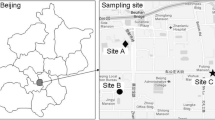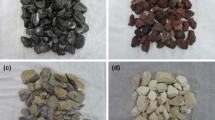Abstract
In the northern Great Plains, a potential road dust abatement is the application of oil-well produced water, also known as “brine.” However, little is known about the effectiveness of brine or its potential impacts on dispersion of road materials and the creation of dusts. This study aimed to investigate how sodium adsorption ratios (SAR), electrical conductivity (EC), and Ca/Mg ratios of simulated and non-simulated brine influenced dispersive reactions of three mineralogically different gravel road fine fractions. Ca/Mg ratios had little to no significant influence on the outcome of dispersion. Irrespective of the SAR or clay mineralogy, a threshold EC of 4 dS m−1 was sufficient to control road fine fraction dispersion. Actual oil-well produced water effect on dispersion followed the same order as that treated by simulated solution and the dispersion value can be well-predicted from EC. This information is useful to managers, regulators, scientists, and industry professionals considering the use of brine as a road dust control abatement.




Similar content being viewed by others
References
Alves, C. A., Evtyugina, M., Vicente, A. M. P., Vicente, E. D., Nunes, T. V., Silva, P. M. A., Duarte, M. A. C., Pio, C. A., Amato, F., & Querol, X. (2018). Chemical profiling of PM10 from urban road dust. Science of the Total Environment, 634, 41–51.
Chavali, R. V. P., Vindula, S. K., Reddy, H. P. P., Babu, A., & Pillai, R. J. (2017). Swelling behavior of kaolinitic clays contaminated with alkali solutions: A micro-level study. Applied Clay Science, 135, 575–582.
Curtin, D., Steppuhn, H., & Selles, F. (1994a). Clay dispersion in relation to Sodicity, electrolyte concentration, and mechanical effects. Soil Science Society of America Journal, 58, 955–962.
Curtin, D., Steppuhn, H., & Selles, F. (1994b). Effects of magnesium on cation selectivity and structural stability of sodic soils. Soil Science Society of America Journal, 58, 730–737.
Dang, A., Bennett, J. M., Marchuk, A., Biggs, A., & Raine, S. R. (2018). Quantifying the aggregation-dispersion boundary condition in terms of saturated hydraulic conductivity reduction and the threshold electrolyte concentration. Agricultural Water Management, 203, 172–178.
Dontsova, K. M., & Norton, L. D. (2002). Clay dispersion, infiltration, and erosion as influenced by exchangeable Ca and Mg. Soil Science, 167, 184–193.
Environmental Protection Agency. (2006). Unpaved Roads. https://www3.epa.gov/ttnchie1/ap42/ch13/final/c13s0202.pdf. Accessed 14 Mar 2018.
Environmental Protection Agency. (2015). 2011 National Emissions Inventory, version 1 Technical Support Document. Research Triangle Park, North Carolina. https://www.epa.gov/air-emissions-inventories/2011-national-emission-inventory-nei-report. Accessed 14 Mar 2018.
Farmer, A. M. (1993). The effects of dust on vegetation - a review. Environmental Pollution, 79, 63–75.
Flynn, S.L., von Gunten, K., Warchola, T., Snihur, K., Forbes, T.Z., Goss, G.G., Gingras, M.K., Konhauser, K.O., & Alessi, D.S. (2018). Characterization and implications of solids associated with hydraulic fracturing flowback and produced water from the Duvernay Formation, Alberta, Canada. Environmental Science, Processes & Impacts, https://doi.org/10.1039/c8em00404h.
Graber, K., Hargiss, C. L. M., Norland, J. E., & DeSutter, T. (2017). Is oil-well produced water effective in abating road dust? Water, Air, &Soil Pollution. https://doi.org/10.1007/s11270-017-3640-x.
He, Y., DeSutter, T. M., & Clay, D. E. (2013). Dispersion of pure clay minerals as influenced by calcium/magnesium ratios, sodium adsorption ratio, and electrical conductivity. Soil Science Society of America Journal, 77, 2014–2019.
Hu, F., Liu, J., Xu, C., Wang, Z., Liu, G., Li, H., & Zhao, S. (2018). Soil internal forces initiate aggregate breakdown and splash erosion. Geoderma, 320, 43–51.
Jayarathne, A., Egodawatta, P., Ayoko, G. A., & Goonetilleke, A. (2018). Assessment of ecological and human health risks of metals in urban road dust based on geochemical fractionation and potential bioavailability. Science of the Total Environment, 635, 1609–1619.
Kondash, A., & Vengosh, A. (2015). Water footprint of hydraulic fracturing. Environmental Science & Technology Letters, 2, 276–280.
Kumar, A., & Elumalai, S. P. (2018). Influence of road paving on particulate matter emission and fingerprinting of elements of road dust. Archives of Environmental Contamination and Toxicity, 75, 424–435.
Lauer, N. E., Harkness, J. S., & Vengosh, A. (2016). Brine spills associated with unconventional oil development in North Dakota. Environmental Science and Technology, 50, 5389–5397.
Liu, D., & She, D. (2017). Sodicity effects on hydrological processes of sodic soil slopes under simulated rainfall. Hydrological Processes, 31, 981–994.
Liu, D., Edraki, M., & Berry, L. (2018). Investigating the settling behaviour of saline tailing suspensions using kaolinite, bentonite, and illite clay minerals. Powder Technology, 326, 228–236.
Lunsford, G. B., & Mahoney, J. P. (1998). Dust control on low volume roads - a review of techniques and chemicals used. Washington, D.C..
Marchuk, S., & Marchuk, A. (2018). Effect of applied potassium concentration on clay dispersion, hydraulic conductivity, pore structure and mineralogy of two contrasting Australian soils. Soil & Tillage Research, 182, 35–44.
Marchuk, A., Rengasamy, P., McNeill, A., & Kumar, A. (2012). Nature of the clay - cation bond affects soil structure as verified by X-ray computed tomography. Soil Research, 50, 638–644.
Marchuk, A., Rengasamy, P., & McNeill, A. (2013). Influence of organic matter, clay mineralogy, and pH on the effects of CROSS on soil structure is related to the zeta potential of the dispersed clay. Soil Research, 51, 34–40.
Michigan Department of Natural Resources. (1983). The use of oil field brine on Michigan roadways. http://www.michigan.gov/documents/deq/Oil_Field_Brine_opt_306999_7.pdf. Accessed 14 Mar 2018.
Mohamed, A. M. O., & Bassouni, K. M. (2007). Externalities of fugitive dust. Environmental Monitoring and Assessment, 130, 83–98. https://doi.org/10.1007/s10661-006-9452-x.
North Dakota Department of Health. (2013). Guidelines for the use of oilfield salt brines for dust and ice control. Unpublished internal report. https://deq.nd.gov/Publications/WQ/1_GW/general/ IceDustControlUsingOilfieldBrine_20130321.pdf. Accessed 13 Nov 2017.
Ohio Department of Natural Resources. (2004). Spreading Oil-Field Brine for Dust and Ice Control in Ohio-A Guidance for Local Authorities. http://oilandgas.ohiodnr.gov/portals/oilgas/pdf/Brine.pdf. Accessed 14 Mar 2018.
Panayiotopoulos, K. P., Barbayiannis, N., & Papatolios, K. (2004). Influence of electrolyte concentration, sodium adsorption ratio, and mechanical disturbance on dispersed clay particle size and critical flocculation concentration in alfisols. Communications in Soil Science and Plant Analysis, 35, 1415–1434.
Pennsylvania Department of Environmental Protection. (2015). Roadspreading of Brine for Dust Control and Road Stabilization. http://www.dep.pa.gov/Business/Energy/OilandGasPrograms/OilandGasMgmt/Documents/8000-FS-DEP1801.pdf. Accessed 14 Mar 2018.
Piechota, T.C., Ee, J. Van, Stave, K.A., & James, D.E. (2002). Potential environmental impacts of dust suppressants: “Avoiding another Times Beach”. Las Vegas, Nevada. Environmental protection agency document EPA/600/R-04/031.
Rajaram, B. S., Suryawanshi, P. V., Bhanarkar, A. D., & Rao, C. V. C. (2014). Heavy metals contamination in road dust in Delhi city, India. Environmental Earth Sciences, 72, 3929–3938.
Rengasamy, P., & Marchuk, A. (2011). Cation ratio of soil structural stability (CROSS). Soil Research, 49, 280–285.
Turkoz, M., Savas, H., Acaz, A., & Tosun, H. (2014). The effect of magnesium chloride solution on the engineering properties of clay soil with expansive and dispersive characteristics. Applied Clay Science, 101, 1–9.
U.S. Salinity Laboratory Staff. (1954). Diagnosis and improvement of saline and alkali soils. Agric.Handbook No. 60. USSL, Riverside, CA, USA
United States Geological Survey. (2018). U.S. Geological Survey National Produced Waters Geochemical Database v2.2 (PROVISIONAL). https://energy.usgs.gov/EnvironmentalAspects/EnvironmentalAspectsofEnergyProductionandUse/ProducedWaters.aspx. Accessed 14 Mar 2018.
Vukadinovic, V., & Rengel, Z. (2007). Dynamics of sodium in saline and sodic soils. Communications ins Soil Science and Plant Analysis, 38, 2077–2090.
Zanobetti, A., & Schwartz, J. (2009). The effect of particle air pollution and its components on mortality: a national analysis. Journal of Materials in Civil Engineering. https://doi.org/10.1164/ajrccm-conference.2009.179.1_MeetingAbstracts.A4734.
Zhang, X. C., & Norton, L. D. (2002). Effect of exchangeable Mg on saturated hydraulic conductivity, disaggregation and clay dispersion of disturbed soils. Journal of Hydrology, 260, 194–205.
Acknowledgements
We would like to thank Kevin Horsager, Alexis Steinman, Amy Gnoinsky, Jordan Roob, and Jeremy Hackley for their extensive help in the lab.
Funding
This project was funded by the North Dakota State University and USDA National Institute of Food and Agriculture Hatch project number ND02396.
Author information
Authors and Affiliations
Corresponding author
Additional information
Publisher’s Note
Springer Nature remains neutral with regard to jurisdictional claims in published maps and institutional affiliations.
Electronic supplementary material
ESM 1
(DOCX 22 kb)
Rights and permissions
About this article
Cite this article
Graber, K., Hargiss, C.L.M., DeSutter, T. et al. Dispersion of Gravel Road Fine-Fractions as Influenced by Oil-Well Produced Water and Simulated Solutions of Various SAR, EC, and Ca/Mg Ratios. Water Air Soil Pollut 230, 61 (2019). https://doi.org/10.1007/s11270-019-4111-3
Received:
Accepted:
Published:
DOI: https://doi.org/10.1007/s11270-019-4111-3




